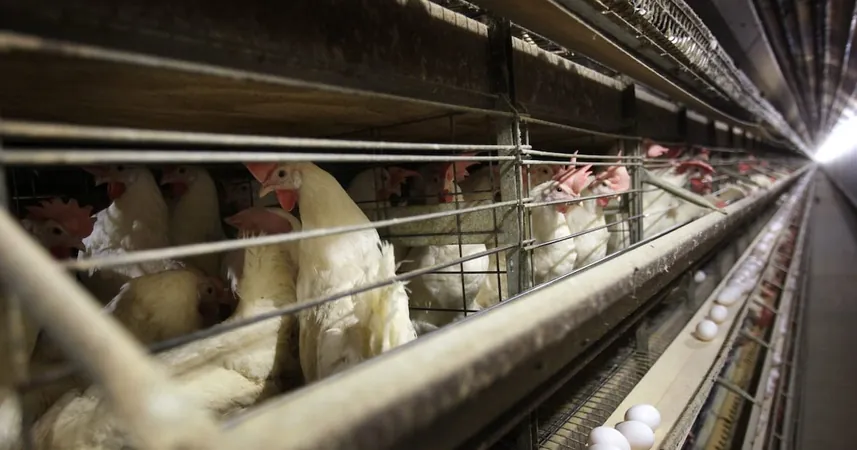
The Future of Protein: Unpacking the Lab-Grown Meat Revolution
2024-11-02
Author: Amelia
Introduction
In recent years, discussions surrounding food have shifted dramatically, particularly regarding the health implications of excessive meat consumption and the environmental toll of the meat industry. As consumers become more health-conscious and environmentally aware, the demand for alternative proteins—both plant-based and lab-grown—has surged.
The Role of Research and Innovation
Scientists and innovators are now working tirelessly to create meat alternatives that mimic the textures and flavors of traditional animal meats, but the journey is fraught with challenges. At the University of British Columbia (UBC), researchers are pioneering advancements in food technology, aiming to enhance the nutritional profile and sustainability of these products.
Amir Amiri's Research
One of the key players in this field is Amir Amiri, a PhD student in the Food Process Engineering Lab, who is focused on an ambitious project that seeks to replicate the luxurious taste and texture of wagyu beef using plant-based ingredients. Amiri outlines three primary methods for producing protein alternatives: plant-based proteins, single-cell proteins, and cultured proteins derived from animal cells.
Single-Cell Proteins and Cultured Proteins
Single-cell proteins are sourced from microorganisms like yeast, while cultured proteins are obtained from lab-grown meat, a process that involves collecting stem cells from live animals and nurturing them in a controlled, nutrient-rich environment to recreate the characteristics of real meat. Amiri believes that the future of these protein alternatives lies predominantly in cultured proteins, heralding a new era for the food industry.
Reshaping Proteins
The most intricate aspect of Amiri's research revolves around reshaping the proteins so that lab-grown meat can truly emulate the texture and flavor found in conventional meat. Traditional animal proteins possess a fibrous structure akin to muscle fibers, while the proteins Amiri works with initially have a globular shape. Through a technique called extrusion, Amiri is able to manipulate these proteins, using high pressure and temperature to alter their structure and then cooling them to form meat-like fibers.
Nutritional Comparisons
While the processing of alternative proteins may appear more complex than their animal-based counterparts, there are nutritional comparisons worth noting. Felicia Tsam, a registered holistic nutritionist, emphasizes key differences between traditional meats and plant-based options. For instance, plant-based proteins are cholesterol-free—unless combined with animal-derived ingredients—making them a heart-friendly choice.
Sodium Content and Health Implications
Another noteworthy point raised by Tsam is sodium content. Many plant-based meats contain added sodium, while consumers typically control the salt levels when preparing traditional meat. Despite this, studies show no significant changes in blood pressure between those consuming plant-based and traditional meat, as seasoning is a common practice across the board.
Vitamin and Mineral Content
Furthermore, plant-based alternatives often offer more consistent vitamin and mineral content. Many of these foods are fortified with nutrients like iron and vitamin B12, essential for individuals following a plant-based diet. This fortification can render plant-based options more nutritionally robust, especially in comparison to varied cuts of animal meat.
Government Initiatives
As academic researchers pivot their focus toward alternative proteins, government entities are also taking notice. The latest version of Canada’s Food Guide promotes frequent consumption of plant foods, highlighting their high fiber and low saturated fat content as key benefits. Tsam advocates for policies that would make these nutritious options more accessible, suggesting that subsidies for fruits, vegetables, whole grains, and legumes could lower costs and enhance public health.
Conclusion
As the lab-grown meat revolution unfolds, it beckons a future where our protein choices might not only satisfy our taste buds but also align with our health aspirations and environmental values. The notion of “who got (lab-grown) beef” may soon become a culinary standard, opening a new chapter in the way we think about food.









 Brasil (PT)
Brasil (PT)
 Canada (EN)
Canada (EN)
 Chile (ES)
Chile (ES)
 España (ES)
España (ES)
 France (FR)
France (FR)
 Hong Kong (EN)
Hong Kong (EN)
 Italia (IT)
Italia (IT)
 日本 (JA)
日本 (JA)
 Magyarország (HU)
Magyarország (HU)
 Norge (NO)
Norge (NO)
 Polska (PL)
Polska (PL)
 Schweiz (DE)
Schweiz (DE)
 Singapore (EN)
Singapore (EN)
 Sverige (SV)
Sverige (SV)
 Suomi (FI)
Suomi (FI)
 Türkiye (TR)
Türkiye (TR)